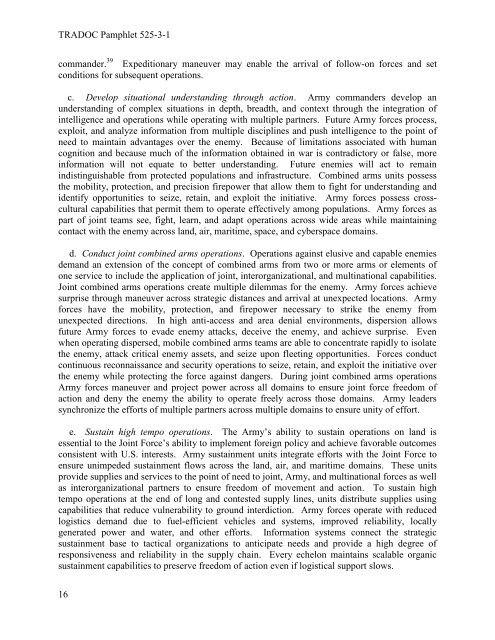TP525-3-1
TP525-3-1
TP525-3-1
You also want an ePaper? Increase the reach of your titles
YUMPU automatically turns print PDFs into web optimized ePapers that Google loves.
TRADOC Pamphlet 525-3-1<br />
commander. 39 Expeditionary maneuver may enable the arrival of follow-on forces and set<br />
conditions for subsequent operations.<br />
c. Develop situational understanding through action. Army commanders develop an<br />
understanding of complex situations in depth, breadth, and context through the integration of<br />
intelligence and operations while operating with multiple partners. Future Army forces process,<br />
exploit, and analyze information from multiple disciplines and push intelligence to the point of<br />
need to maintain advantages over the enemy. Because of limitations associated with human<br />
cognition and because much of the information obtained in war is contradictory or false, more<br />
information will not equate to better understanding. Future enemies will act to remain<br />
indistinguishable from protected populations and infrastructure. Combined arms units possess<br />
the mobility, protection, and precision firepower that allow them to fight for understanding and<br />
identify opportunities to seize, retain, and exploit the initiative. Army forces possess crosscultural<br />
capabilities that permit them to operate effectively among populations. Army forces as<br />
part of joint teams see, fight, learn, and adapt operations across wide areas while maintaining<br />
contact with the enemy across land, air, maritime, space, and cyberspace domains.<br />
d. Conduct joint combined arms operations. Operations against elusive and capable enemies<br />
demand an extension of the concept of combined arms from two or more arms or elements of<br />
one service to include the application of joint, interorganizational, and multinational capabilities.<br />
Joint combined arms operations create multiple dilemmas for the enemy. Army forces achieve<br />
surprise through maneuver across strategic distances and arrival at unexpected locations. Army<br />
forces have the mobility, protection, and firepower necessary to strike the enemy from<br />
unexpected directions. In high anti-access and area denial environments, dispersion allows<br />
future Army forces to evade enemy attacks, deceive the enemy, and achieve surprise. Even<br />
when operating dispersed, mobile combined arms teams are able to concentrate rapidly to isolate<br />
the enemy, attack critical enemy assets, and seize upon fleeting opportunities. Forces conduct<br />
continuous reconnaissance and security operations to seize, retain, and exploit the initiative over<br />
the enemy while protecting the force against dangers. During joint combined arms operations<br />
Army forces maneuver and project power across all domains to ensure joint force freedom of<br />
action and deny the enemy the ability to operate freely across those domains. Army leaders<br />
synchronize the efforts of multiple partners across multiple domains to ensure unity of effort.<br />
e. Sustain high tempo operations. The Army’s ability to sustain operations on land is<br />
essential to the Joint Force’s ability to implement foreign policy and achieve favorable outcomes<br />
consistent with U.S. interests. Army sustainment units integrate efforts with the Joint Force to<br />
ensure unimpeded sustainment flows across the land, air, and maritime domains. These units<br />
provide supplies and services to the point of need to joint, Army, and multinational forces as well<br />
as interorganizational partners to ensure freedom of movement and action. To sustain high<br />
tempo operations at the end of long and contested supply lines, units distribute supplies using<br />
capabilities that reduce vulnerability to ground interdiction. Army forces operate with reduced<br />
logistics demand due to fuel-efficient vehicles and systems, improved reliability, locally<br />
generated power and water, and other efforts. Information systems connect the strategic<br />
sustainment base to tactical organizations to anticipate needs and provide a high degree of<br />
responsiveness and reliability in the supply chain. Every echelon maintains scalable organic<br />
sustainment capabilities to preserve freedom of action even if logistical support slows.<br />
16


